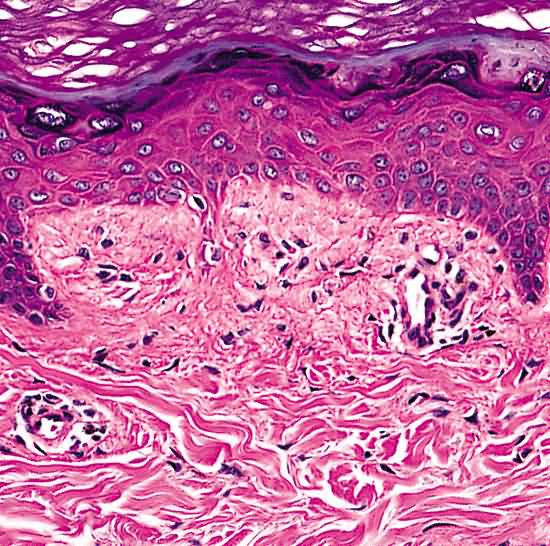Definition
A condition in which deposits of a fibrillary protein (amyloid) appear in the skin as macules, papules, and nodules consequent to the effects of local factors, or as patches (which may be purpuric), plaques, nodules, and tumors as a result of a systemic disease like myeloma.
Adjunctive Diagnostic Tests
Specialized stains for amyloid include Congo red and thioflavin-T combined with fluorescence. Fine-needle biopsy of subcutaneous fat in clinically normal abdominal skin or biopsy of the mucosa of the rectum in systemic amyloidosis permits sampling of tissue that houses amyloid. Laboratory tests and special examinations are vehicles to demonstrate myeloma-associated systemic amyloidosis.
Course
The course of cutaneous amyloidosis depends on the type of the disease. For example, the most common type of amyloidosis in the skin consists of pigmented macules that form a reticulated pattern on sites of predilection, namely, interscapular and pretibial areas. When the macules are rubbed firmly for years, they become keratotic papules. If macular and papular lesions of amyloidosis can be protected completely from being scratched and rubbed, the lesions slowly resolve and largely disappear, the only residuum being pigmentation.
A nodule of amyloidosis usually is a wholly cutaneous lesion unrelated to any systemic condition. It persists unless it is excised. The cause is not known.
Purpuric macules, patches, nodules, and blisters represent manifestations of systemic amyloidosis as occurs, for example, in paraproteinemia and myeloma. Those lesions come and go for as long as the systemic disease goes unchecked.
Amyloidosis confined to the skin must be managed by assisting the patient to avoid rubbing and scratching, and applying impediments, which include an Unna’s boot on sites like the legs. Application of high-potency corticosteroids under occlusion seems to be beneficial. In some formidable lesions that are resistant to therapy, etretinate, laser surgery, and even dermabrasion have been effective.
Amyloidosis that is systemic must be treated systemically. Attention should be directed to the primary pathologic process; for example, use of chemotherapy for myeloma.


